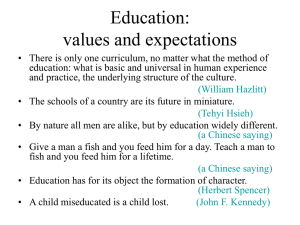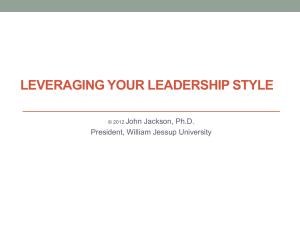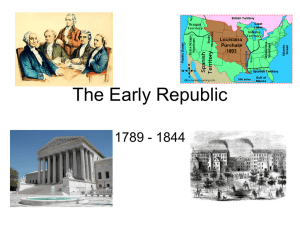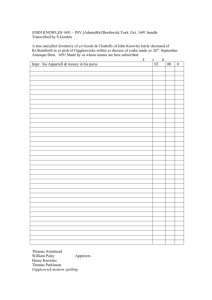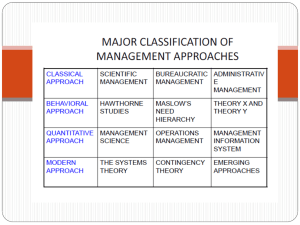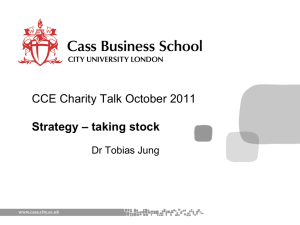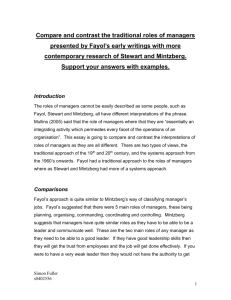Management Philosophy: Schools of Thought & Leadership Styles
advertisement
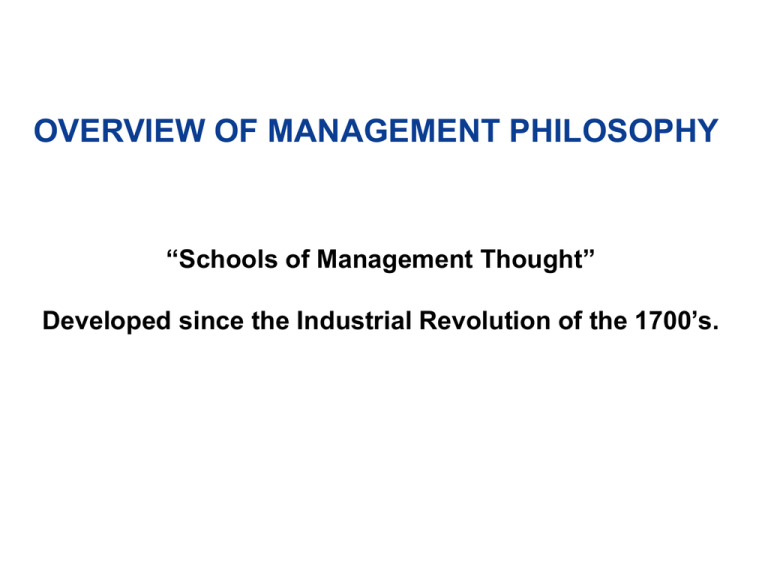
OVERVIEW OF MANAGEMENT PHILOSOPHY “Schools of Management Thought” Developed since the Industrial Revolution of the 1700’s. KEY THEORISTS: • • • • • • • • • Taylor – Scientific Management Fayol – Classical Administration Mayo – Human Relations Mintzberg – Managers Roles McGregor – Leadership Styles Blake & Mouton – Managerial Grid Hersey & Blanchard – Situational Leadership Knowles – Leadership Roles Myers-Briggs – MBTI SCIENTIFIC MANAGEMENT Frederick Taylor Focus: Systematic approach to achieving productivity improvement through task efficiency. Time & motion studies used to gain evidence. Conclusion: Optimum organisation of work, tools supplied and payment incentives results in maximum output. Assumption: Workers are “rational" and primarily want pay rises. Work tasks broken down and reorganised BUT become more routine and boring. Not accepted by unions and workers. CLASSICAL ADMINISTRATIVE SCHOOL Henri Fayol Focus: An efficient and effective organisation depends on it’s management structure. i.e. hierarchy Classical management functions: • Planning • Organising • Controlling • Co-ordinating • Directing • Reporting • Budgeting Principles of Management: • • • • • Division of labour Authority needed Unity of command Relevant remuneration Promotion of team spirit HUMAN RELATIONS SCHOOL Elton Mayo Focus: Viewing employees Relationships central. in ‘human’ terms. “Hawthorne Studies” integral part of research. Conclusion: Work places should be regarded as a social system of significant complexity. ROLES OF MANAGERS What is it that managers do? Fayol: Classical functions Mintzberg: 3 KEY ROLES 1. Interpersonal: • figurehead • leader • liaison 2. Information: • monitor • disseminate • spokesperson 3. Decisions: • entrepreneur • disturbance handler • resource allocator • negotiator Need: technical knowledge, interpersonal skills and conceptual skills MANAGEMENT vs. LEADERSHIP MANAGER: Distinctive and complementary systems of action LEADER: Results through position Results through co-operation and freewill Copes with complexity of modern organisations. Copes with change Develops order and consistency. Communicates a vision. Administers Maintains Relies on control Focus on structure Focus on systems Planning, budgeting, staffing, controlling. Ensures routines are successfully completed Innovates Develops Ideas Inspires trust Focus on people Sets direction Aligning people, motivating, inspiring. Challenge: To combine strong leadership AND strong management LEADERSHIP STYLES: McGregor Personal beliefs about motivation can determine leadership style and action. THEORY X – THEORY Y MODEL OR LEADERSHIP: Theory X Assumptions: • employees are lazy and only work if forced to do so. • employees do not desire responsibility but prefer to be directed and controlled. • employees have no motivation to achieve organisational objectives. • employees are only motivated by physiological and safety needs. Theory Y Assumptions: • employees are not averse to work if organisational conditions are appropriate. Past work experiences may affect their attitude. • employees can be motivated by higher order needs such as self-actualisation and autonomy. • employees seek responsibility to satisfy higher order needs. McGREGOR cont. 2 extremes: X = autocratic, task oriented Y = participative, people oriented In practice extremes are unlikely but most managers adopt mixture of the two. The situation may determine the approach. THE MANAGERIAL GRID Blake & Mouton Employee centred: Production centred: PEOPLE TASK Needs Plan, schedule Relationships Control Conflict resolution Monitor The Grid shows the 2 tendencies for behaviour. ?? Can you always define a person's tendencies and predict behaviour?? What about varying styles for different situations? SUMMARY OF LEADERSHIP STYLES: AUTHORITARIAN: direct others PARTICIPATIVE: share decision making LAISSEZ-FAIRE: let others direct their activities Many leaders use a range of styles suited to the particular situation. Style will affect group performance and motivation. CONTINGENCY THEORIES OF LEADERSHIP: SITUATIONAL LEADERSHIP: Hersey & blanchard. Classifies leader behaviours into 2 categories: • RELATIONSHIPS • TASKS 4 possible leadership styles will result. Leaders will match leadership style to each task. By linking this to "follower type" based on readiness to complete task which is determined by ability and willingness, it is possible to ascertain the most appropriate leadership style to use in each situation. In reality managers are not so flexible and tend to use only 2 styles. LEADERSHIP ROLES: Knowles: Leaders need to perform certain roles to ensure effective results. Roles external to the group: Gathering information, facilitating innovation, representing the group. Roles within the group: Clarifying issues, identifying actions, reviewing progress, developing individuals and the group, handling power issues. **Refer also to Belbin & Knowles group/team roles **Myers-Briggs also looks at roles. MYERS-BRIGGS TYPE INVENTORY Myers-Briggs: Often used in recruiting and developing appropriate teams. **team results determined by the individual members. Testing used to measure various aspects: • Aptitude • Achievement • Psychometric (motivation, personality, behaviour) Examples: Belbin Self assessment Myers-Briggs questionnaire WHY?? • Knowing the individual is the key to managing the team • Important to select the right people MANAGEMENT THEORY Much study and theory A complex area, but understanding the developments over time and the reality of a mixture of theoretical concepts being applied in practice helps to: • Highlight the complex nature of management • Raise awareness of relevant issues and tools • Create a working base for managers. POWER: Due to: • Position • Personality Can be: • Formal • Informal • Positive • Negative



